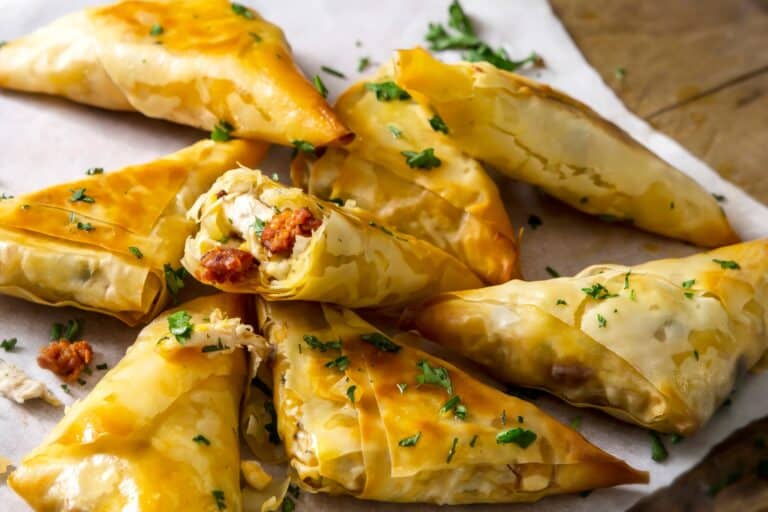At Remitly, we love money transfers and all things finance; but we’re here to delve into life in countries around the globe and explore all aspects of their culture, too. And what better way to learn about a culture than through its food?
In the latest of our national dishes series, we’re exploring the rich, vibrant cuisine of Morocco. The food of this North African country is a reflection of its history, with Berber, Arab, French and Mediterranean influences present in its diverse dishes.
Morocco is known for its spices, and the famous markets in the medina of Marrakech are brimming with cinnamon, cumin, black pepper, turmeric, and ginger that are reminiscent of so many Moroccan dishes.
I’m Sarah and I recently visited the country for the first time and was captivated by the flavors and aromas of Marrakesh.
Moroccan cuisine is more diverse than I knew, and goes far deeper than the tagines and couscous that initially come to mind. Let’s discover some of the most common and delicious Moroccan dishes.
Table of contents
Must-try Moroccan dishes
Tagine
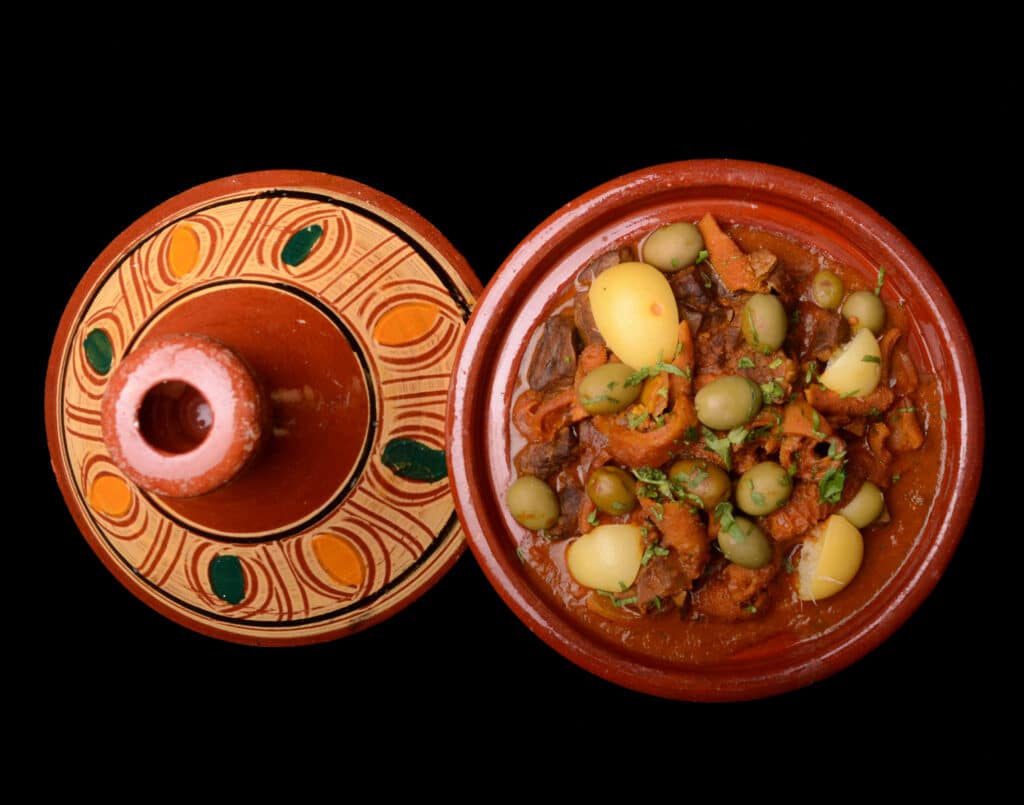
The tagine is probably one of the most famous dishes in Moroccan cuisine—and for good reason. The name for the dish comes from the recognizable conical earthenware pot it’s traditionally cooked in.
Tagine is an extremely versatile dish made with a variety of ingredients, including meat, seafood and vegetables, usually with a mix of dried fruits and nuts. It’s a symbol of tradition and Moroccan hospitality and is often eaten communally.
I tried several different tagines during my time in Marrakech, including beef with prunes and almonds; Moroccan chicken tagine with preserved lemon and green olives; lamb kefta (meatballs) with apricots; and vegetable. All were the perfect balance of sweet and savory, creating a unique and delicious flavor profile that I found to be very typical of Moroccan cooking. In addition to the vibrant flavors of Moroccan tagines, my culinary journey also included exploring how traditional Portuguese cuisine highlights the use of fresh, local ingredients. Dishes like bacalhau à brás and caldo verde showcased the rich diversity and cultural influences of Portugal, offering a different yet equally satisfying flavor experience. Each meal felt like a celebration of the region’s unique history and its connection to the land.
More about Morocco
Couscous
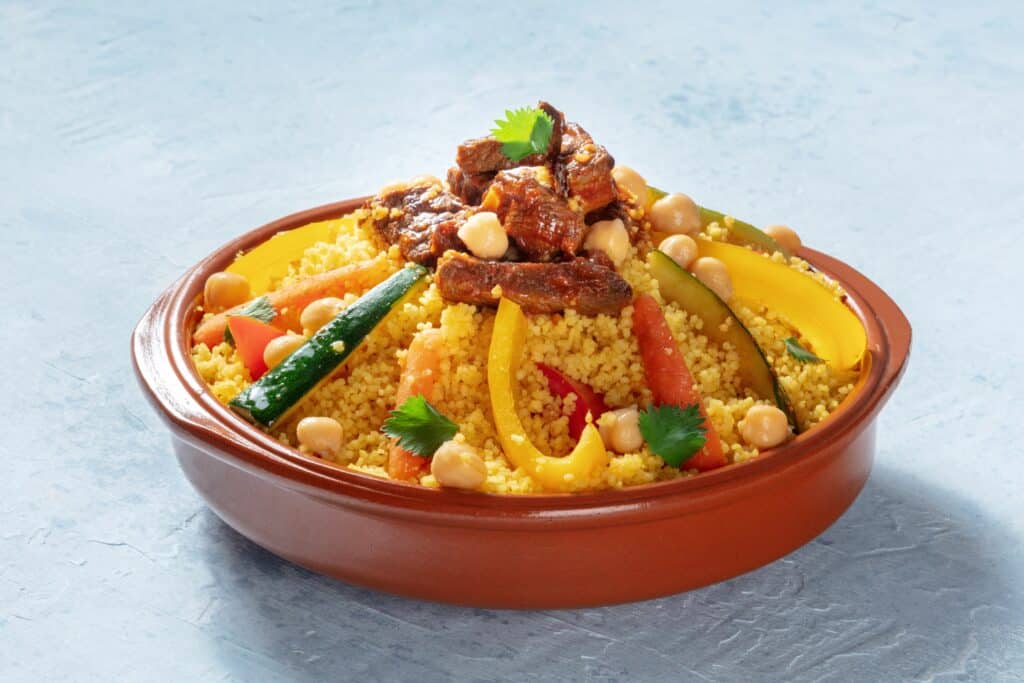
Couscous is another iconic dish in Moroccan cuisine that’s also popular in other parts of North Africa. In Morocco, it’s often served on special occasions, and is a way of bringing families and friends together. It’s often served in one big dish, which people gather around and eat from directly. The name comes from the couscous grain itself, which is made from semolina (a type of wheat flour). Traditional cooking methods see it steamed several times over a broth to give it its characteristic light, fluffy texture.
Couscous is served with meat or seafood and a variety of veggies, alongside a tasty broth. The veggies may depend on the season but typically include onions, carrots, pumpkin, zucchini, and turnips. The veggie couscous I tried also had some delicious, plump chickpeas and juicy white cabbage, both of which were the perfect addition to a filling and healthy meal.
Moroccan mint tea
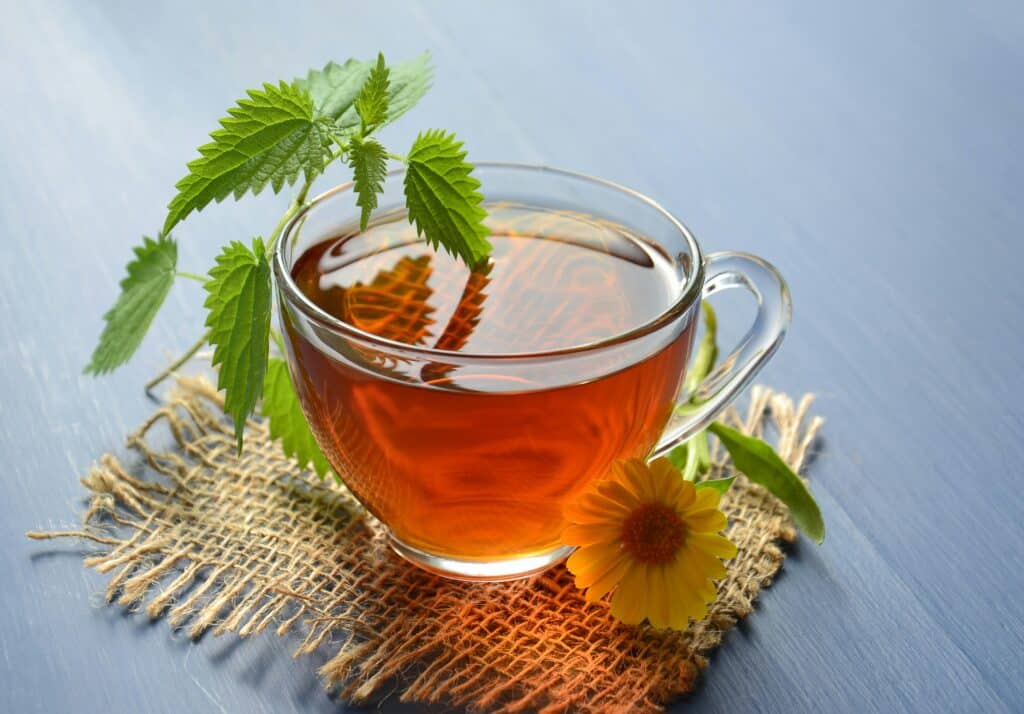
Moroccan mint tea is probably the most famous Moroccan drink, and Moroccans drink a lot of it. It’s consumed throughout the day and is also served as a gesture of hospitality. When I arrived at my riad (my accommodation for the trip, a traditional Moroccan house), I was immediately offered a seat in the courtyard and offered some tea as a welcome. The tea is served in small glasses and usually consists of green tea—specifically Chinese gunpowder tea—fresh mint leaves, and sugar.
The serving of the tea is a key part of the presentation. Using a teapot with a long and thin snout, the tea is poured into the glass from a height, which aerates it, creates a froth, and cools the tea down so it can be enjoyed straight away.
Seffa
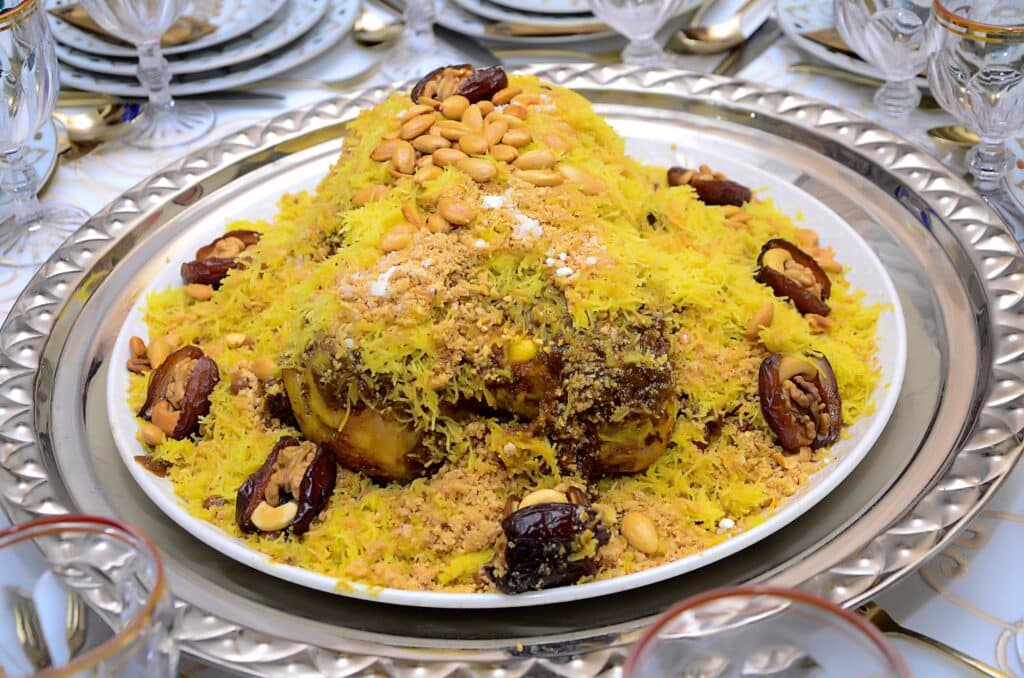
Seffa is a dish that signifies joy and festivity, and it is often served on special occasions. I came across it almost by accident, in a restaurant whose menu displayed nothing more than the name of the dish. Following a brief description from the waiter, I decided to give it a go; it was so good, that I went back two days later to have it again.
Once again, the combination of sweet and savory is a key element of the dish: marinated chicken is cooked slowly with onions and spices, hidden beneath a bed of buttery vermicelli noodles. It’s topped with intensely flavored caramelized onions, almonds and sweet prunes, and sprinkled with cinnamon and powdered sugar.
The combination of flavors was completely new to me, but I loved it and can’t recommend it highly enough.
Briouat
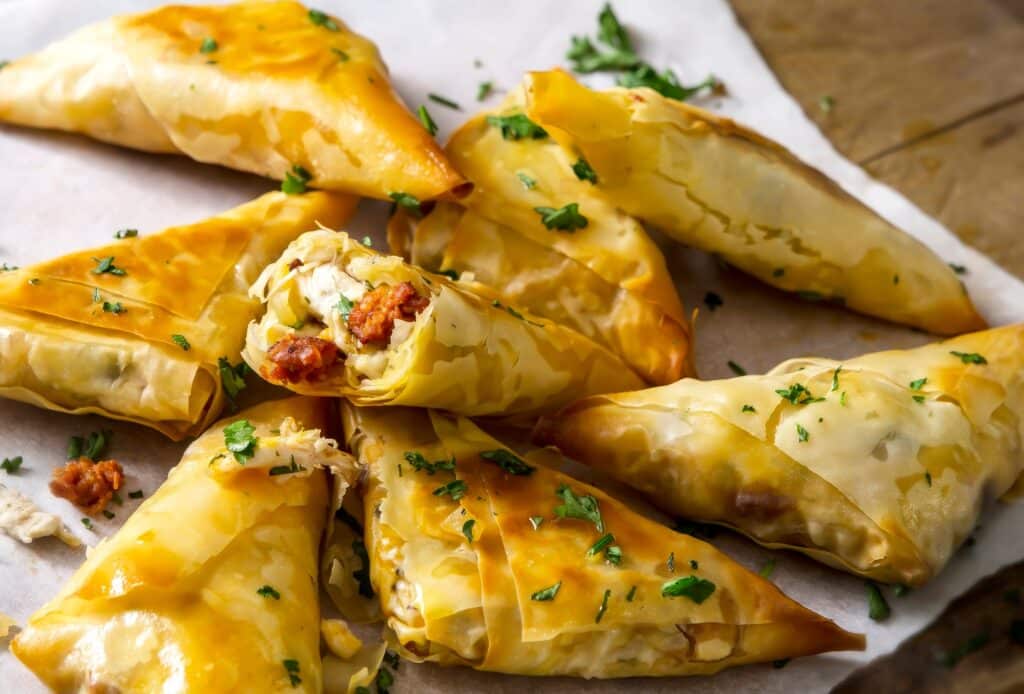
These crispy stuffed triangles are a common item on menus in Morocco, and you can also find them in the many food markets and street food stalls. The name probably comes from the Arabic word briwa, meaning “letter” or “note,” reflected in the briouat’s shape, which resembles a folded letter.
Briouat are made from a thin pastry similar to filo and come with both sweet and savory fillings, such as ground meat, cheese, vegetables, or almond paste flavored with cinnamon or orange blossom. The contrasting textures and delicious fillings provide a delicious snack or appetizer. They are served both as an everyday item and at special occasions.
Gazelle horn (Kaab el ghazal)
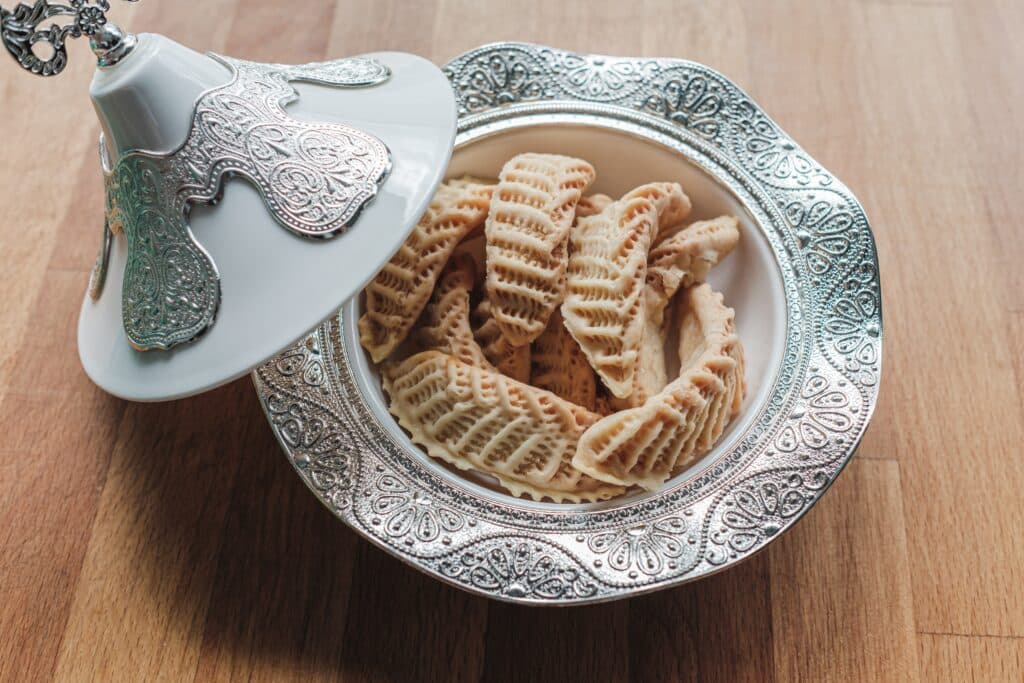
This traditional Moroccan pastry is crescent-shaped, resembling the horns of a gazelle, giving the sweet treat its name. A delicate exterior made from a buttery dough is filled with an almond-based paste flavored with orange blossom. The pastries are a perfect accompaniment to a glass of mint tea. Recipes for kaab el ghazal have been passed down through generations and are another important symbol of Moroccan hospitality.
Pastilla
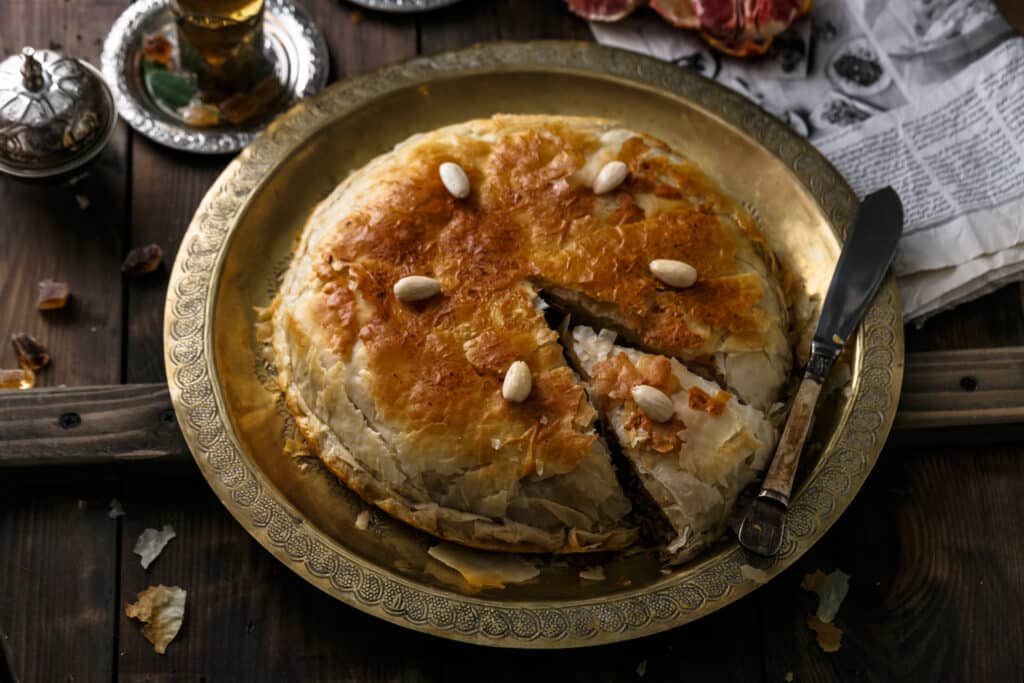
Pastilla (or bastilla) is a filo pastry pie, mostly typically stuffed with a tender mix of chicken, onions, almonds, herbs and spices. Its roots can be traced back to the Moorish traditions of Andalusia, Spain, and the name itself comes from the Spanish word pastilla, meaning “small pastry” or “pill.”
The pie is baked until golden brown before being dusted with cinnamon and powdered sugar to add the common sweet element. While chicken is the most common filling, you may also find pastilla stuffed with cheese, vegetables, seafood such as shrimps or sardines, or even pigeon.
Msemen
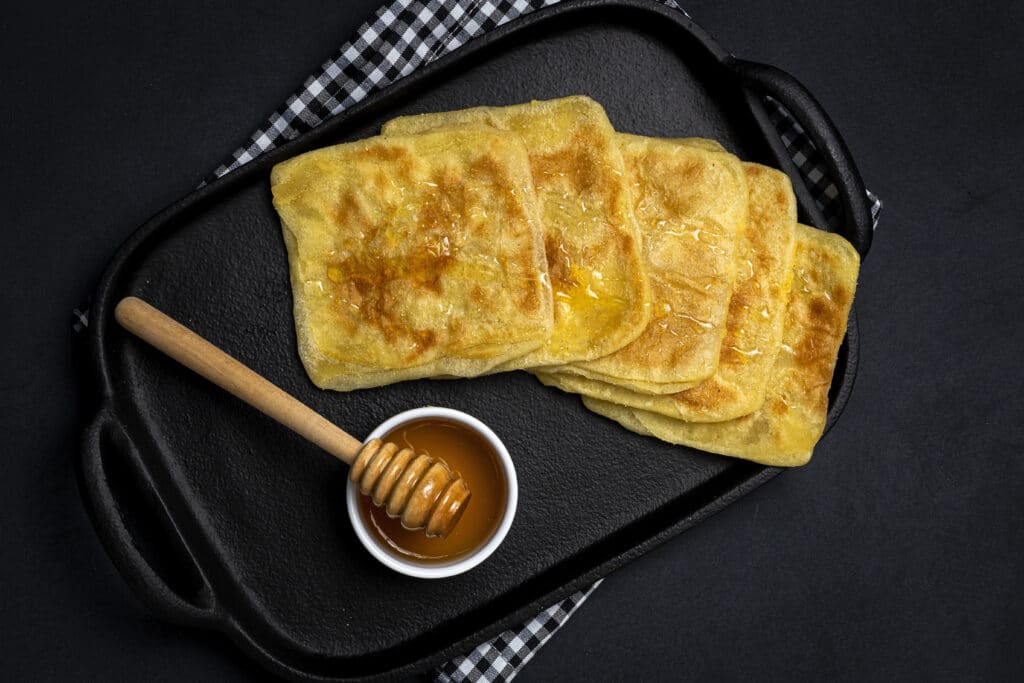
Msemen is a traditional Moroccan flatbread (also referred to as a pancake) that’s been a staple in North Africa for centuries. It’s made from a dough that’s folded into a square, then cooked on a hot surface to create a crispy exterior with soft, flaky layers inside.
I ate these every day for breakfast, fresh from the pan and drizzled with honey, jam, or butter. They’re a great way to start the day alongside a coffee or Moroccan mint tea.
Harira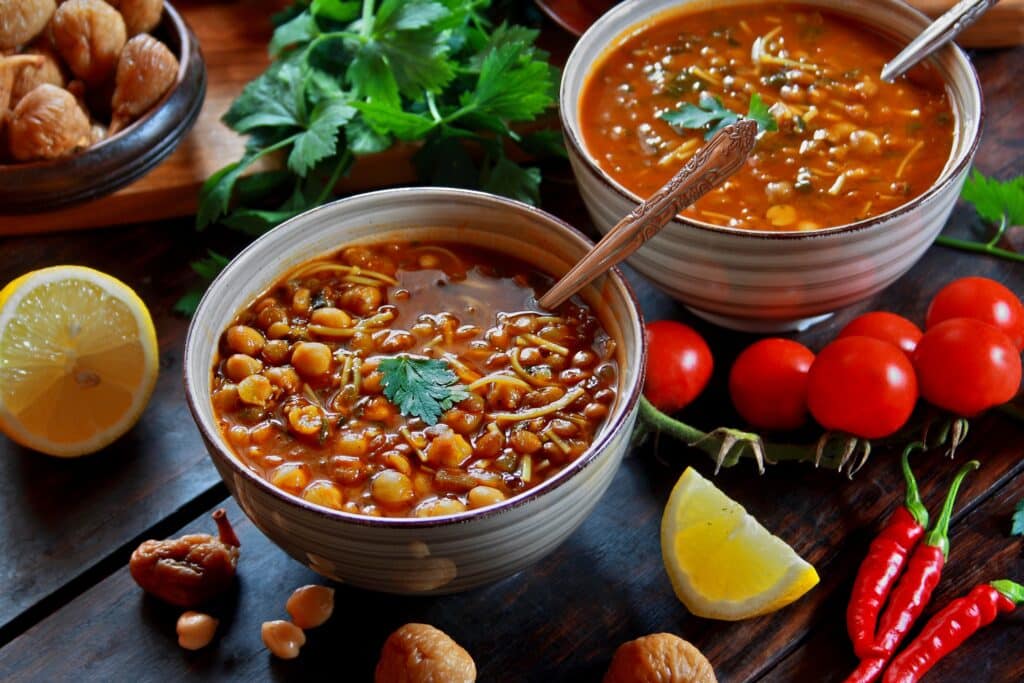
“Harira” comes from the Arabic word harir, meaning “silk,” which probably refers to the dish’s smooth texture. This delicious and warming soup is made from a base of tomatoes, lentils and chickpeas, seasoned with an aromatic blend of Moroccan spices including ginger, cinnamon and black pepper. Further flavor comes from fresh herbs such as cilantro or parsley and you may also see an addition of meat, vegetables, rice, additional spices, or lemon juice.
Harira is a staple dish in Moroccan cuisine and is often served to break the fast during Ramadan and on Moroccan Independence Day.
Zaalouk
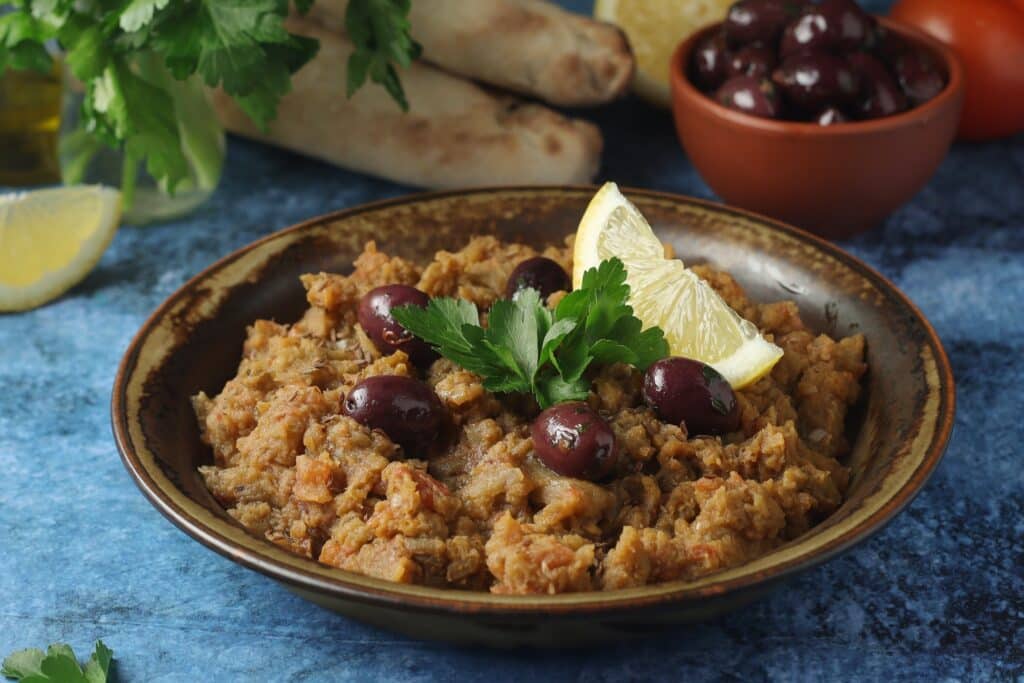
Smoky, roasted or grilled eggplant are the star of the show in this dip, whose name originates from Arabic. It’s typically served as a side dish or appetizer alongside other traditional dips and salads.
The eggplants are added to a tomato sauce containing olive oil, garlic and spices and then reduced to a rich mixture. Fresh herbs and lemon juice create additional layers of flavor to a popular and versatile dish that’s widely served as part of an everyday meal. I loved it.
Chebakia
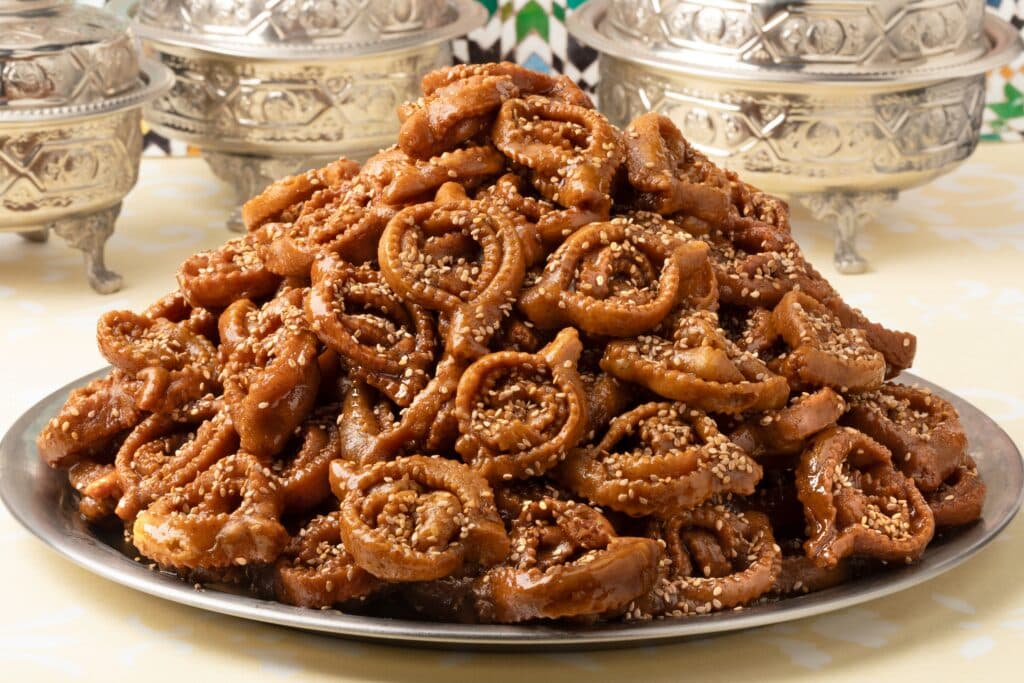
Chebakia are Moroccan, flower-shaped cookies that are fried before being soaked in honey and coated in sesame seeds. The intricate detail of the cookies is reflected in Its name, which comes from the Arabic word “chabaka,” meaning “to weave.” Chebakia are often served alongside harira at iftar, the meal that breaks the daily fast during the Islamic holy month of Ramadan.
Other Moroccan dishes you can’t miss
Don’t miss out on these other delicious dishes:
Tanjia
A typical dish of Marrakech. Meat (usually beef or lamb) is mixed with spices to create a flavorful marinade, before being placed in a clay pot—a tanjia—before being sealed and slow-cooked. The result is a meltingly tender stew.
Mechoui
Mechoui is traditionally made using a whole lamb, but can be a leg or shoulder for smaller portions. The meat is marinated in a mixture of spices, garlic and herbs before being roasted or spit-roasted.
Rfissa
Chicken, lentil and onions are stewed in a broth with a blend of spices including fenugreek and saffron, then served on a base of shredded msemen or other bread or pastry.
Exploring Moroccan cuisine in Paris
Paris has one of the largest Moroccan expat communities outside Morocco, which is due in part to historical connections between France and Morocco. After Morocco gained independence in 1956, there was a wave of migration to France, and Paris was one of the cities where a vibrant Moroccan community grew. As a result, there are a wide range of Moroccan restaurants, tea houses, bakeries and markets where you can find authentic Moroccan dishes and produce.
A world of flavor to be discovered
We hope this glimpse into the tantalizing cuisine of Morocco will tempt you to discover and enjoy Moroccan food. Whether you create your own, home dining experience or travel to Morocco, its cuisine will provide a dining experience that will delight your taste buds.
Which Moroccan Dishes Would Be a Hit at a Fourth of July Party?
Elevate your celebration with vibrant Moroccan dishes as part of your fourth of july party recipes. Consider serving a refreshing Moroccan salad with tomatoes, cucumbers, and olives, along with delicious lamb skewers infused with aromatic spices. A sweet and spicy harissa dip pairs perfectly with warm pita, adding a unique twist to your festivities.
FAQ
There are many traditional dishes in Moroccan cuisine. Some of the most well-known dishes are tagine and couscous, and Moroccan mint tea is a popular and widely-consumed drink.
Spices are a crucial part of Moroccan cuisines. Some of the most commonly used spices include cinnamon, ginger, turmeric, coriander, cumin, paprika and black pepper. Ras el hanout is a traditional spice blend that is often used to enhance the flavor of different dishes.
Chermoula is often used as a sauce or marinade in many Moroccan recipes. It contains fresh herbs such as cilantro or parsley, as well as garlic, spices and lemon juice. Harissa is another common condiment or sauce, made from a base of chili peppers.
While meat is present in many Moroccan dishes, such as tagine, couscous, kefta, or kebab, there is also a wide range of vegetarian or vegan dishes.
There are many authentic recipes available online, and depending on your location, ingredients should be readily available. See the article for links to some recipes you can try at home.
